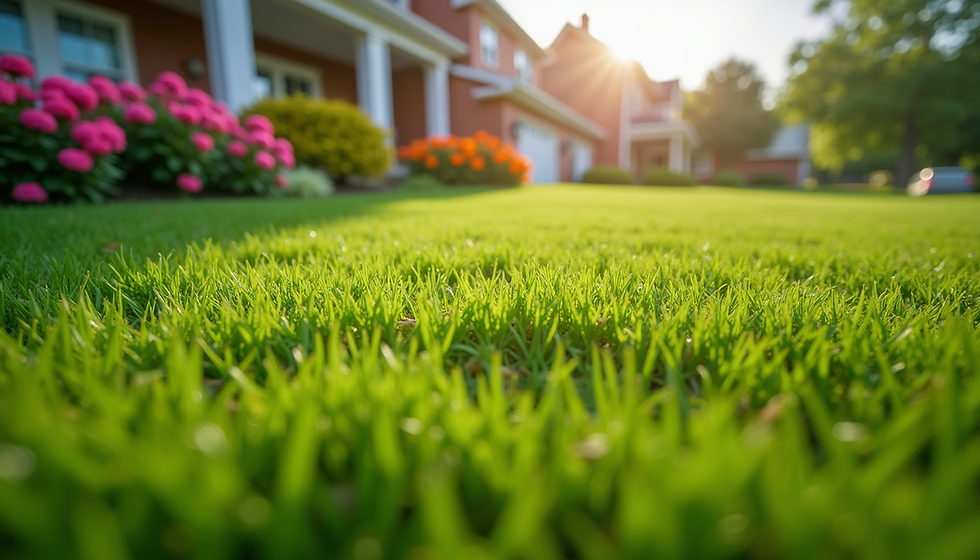Dethatching vs. Aeration—Which Does Your Lawn Need This Spring?
- Timothy Jacobs
- Mar 22
- 3 min read
Spring is in the air, and it’s time to give your lawn the attention it needs to recover from winter and thrive in the months ahead. Two common but often misunderstood techniques are dethatching and aeration. While both aim to improve your turf’s overall health, they accomplish this in different ways. Below, we’ll explain the difference between the two and help you decide which is right for your lawn this season.
1. What Is Thatch, and Why Does It Matter?
Thatch is a layer of dead and living grass, leaves, stems, and roots that accumulates between the soil surface and the green grass above. A small amount of thatch (around half an inch) can actually benefit your lawn by conserving moisture and insulating roots. However, when thatch gets too thick, it creates problems such as:
Preventing water, nutrients, and oxygen from reaching roots
Harboring pests and diseases
Creating uneven or patchy growth patterns
Dethatching breaks up this thick layer, allowing your lawn to “breathe” again and access essential resources it needs to grow.
2. The Dethatching Process
Dethatching can be done using special rakes or machinery designed to pull up and break apart thatch. The key is to remove enough of the thatch layer to help your grass, but not so much that you damage healthy roots. Early spring (once your lawn has started greening) is often a good time for dethatching because it helps your grass recover quickly with seasonal rains and warming temperatures.
3. Why Aeration Matters
Soil compaction is another issue that can hinder a lawn’s ability to thrive. Heavy foot traffic or wet winter conditions compress the soil, making it difficult for water, nutrients, and air to penetrate. Aeration involves creating small holes in your turf to alleviate this compaction, ultimately helping roots grow deeper and stronger.
4. The Aeration Process
Core aeration uses a machine to remove small plugs of soil and thatch from your lawn, leaving behind holes that let oxygen, water, and nutrients reach the root zone more effectively. Over time, the removed plugs break down and replenish the soil with organic matter, further nourishing your turf.
For many Ohio lawns, spring and early fall are ideal times to aerate—just ensure the ground isn’t overly saturated with water or still frozen. After aeration, you can apply a layer of fertilizer or overseed to fill in thin areas and promote a lush, uniform lawn.
5. Which Is Right for You?
Dethatch if:
Your lawn has excessive thatch buildup (more than half an inch).
You notice spongy or uneven grass growth.
You see signs of mold or pest issues harbored in thick thatch.
Aerate if:
Your soil is heavily compacted.
Water pools on the surface, or it’s hard to dig into the soil with a garden tool.
You have thin or bare patches that need overseeding.
Some lawns benefit from both dethatching and aeration, but the order and timing depend on each lawn’s unique condition. Consult a lawn care professional to determine the most effective plan.
How Lawn Harmony Landscaping LLC Can Help
If you’re unsure whether to dethatch, aerate, or tackle both this spring, let the professionals at Lawn Harmony Landscaping LLC guide you. We serve Franklin, Ross, Pickaway, Fairfield, and Fayette counties with services that include:
Dethatching and Aeration to address lawn congestion and soil compaction.
Mowing, Mulching, and Spring Cleanups to maintain a polished look all season.
Fertilization and Weed Control for healthier, weed-free turf.
Ready for a Healthier Lawn?
Schedule your free quote with Lawn Harmony Landscaping LLC today. Reach out at:
Phone: 614-425-9789
Email: LawnHarmonyOhio@gmail.com
Website: LawnHarmonyLLC.com
Facebook: facebook.com/LawnHarmonyLLC
By understanding the differences between dethatching and aeration, you can choose the right approach to boost your lawn’s health. With the proper techniques in place, your yard will be ready to flourish this spring and beyond. Feel free to get in touch if you have any questions or would like expert help in creating a lush, resilient lawn for the season.











Comments